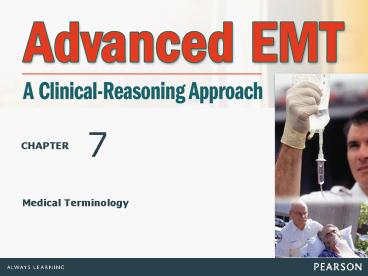Medical Terminology - PowerPoint PPT Presentation
1 / 38
Title:
Medical Terminology
Description:
7 Medical Terminology Teaching Tip: Use a mannequin or skeleton model to demonstrate the anatomical planes. Class Activity: Divide students into pairs. – PowerPoint PPT presentation
Number of Views:312
Avg rating:3.0/5.0
Title: Medical Terminology
1
7
Medical Terminology
2
Advanced EMT Education Standard
- The AEMT uses foundational anatomical and medical
terms and abbreviations in written and oral
communications with colleagues and other health
care professionals.
3
Objectives
- Define key terms introduced in this chapter.
- Use terms of anatomical position, planes, and
direction and movement to describe the anatomy of
the body. 24-29 - Apply knowledge of common medical prefixes,
suffixes, and roots (combining forms) to
determine the meaning of medical terms. 32-35
4
Objectives
- Use common medical terminology in communication
with other health care providers, including
inpatient care documentation. 31-35 - Differentiate between accepted standard and
nonstandard medical symbols and abbreviations.
32-35
5
Introduction
- Every profession has a unique language that
allows precise and efficient transmission of
meaning among individuals who are fluent in the
language.
6
Introduction
- Medical terminology
- Used by health care professionals
- Common prefixes, root words, suffixes
- Common symbols, abbreviations, conventions for
writing numbers
7
Think About It
- How could Cameron rewrite the report using
medical terms? - What are the advantages of using medical terms in
patient care documentation?
8
Think About It
- What are some possible disadvantages of using
medical terms? - What should you do if you cannot remember or are
unsure of a medical term when communicating
orally or in writing?
9
Medical Terminology Basics
- Root word
- Foundation of medical term
10
Medical Terminology Basics
- Table 7-1 Commonly Used Root Words with
Combining Forms.
11
Medical Terminology Basics
- Prefix
- Placed at beginning of root word to modify meaning
12
Medical Terminology Basics
- Table 7-2 Numeric/Quantitative Prefixes.
13
Medical Terminology Basics
- Table 7-3 Common Prefixes.
14
Medical Terminology Basics
- Table 7-3 Common Prefixes.
15
Medical Terminology Basics
- Suffix
- Placed at end of root word to modify meaning
16
Medical Terminology Basics
- Table 7-4 Common Suffixes.
17
Medical Terminology Basics
- Table 7-4 Common Suffixes.
18
Medical Terminology Basics
- Table 7-4 Common Suffixes.
19
Medical Terminology Basics
- Combining vowel
- Connects root word to suffix, or combines two
root words
20
Medical Terminology Basics
- Spelling and pronunciation are important.
- Rules for pluralizing medical terms based on
letter(s) in which the term ends.
21
Medical Terminology Basics
- Table 7-5 Rules for Pluralizing Medical Terms.
22
Medical Terminology Basics
- Avoid jargon or slang.
23
Think About It
- What are the potential consequences of misspelled
or mispronounced medical terms?
24
Anatomical Terms
- Figure 71 Terms of position and direction.
25
Anatomical Terms
- Figure 73 For reference, the body, or any of
its parts, can be divided by imaginary planes.
26
Anatomical Terms
- Figure 74 Many medical terms refer to the main
body cavities.
27
Anatomical Terms
- Terms of position and direction useful in
describing location of body structures and
abnormal findings. - Anatomical position and body planes are points of
reference.
28
Anatomical Terms
- Table 7-6 Terms of Position and Direction.
29
Anatomical Terms
- Table 7-6 Terms of Position and Direction.
30
Think About It
- Proper patient positioning can reduce pain,
improve breathing and increase patient comfort. - Prone
- Left lateral recumbent
- Right lateral recumbent
- Supine
- Fowler
- Semi-Fowler
31
Terms by Body System
- Each body system has particular terms associated
with it. - Musculoskeletal system
- Cardiovascular
- Blood and immune system
- Nervous system
- Respiratory system
- Gastrointestinal system
32
Terms by Body System
- Table 7-13 Commonly Accepted Medical
Abbreviations and Symbols.
33
Terms by Body System
- Table 7-14 Standard Medical Charting
Abbreviations.
34
Terms by Body System
- Table 7-14 Standard Medical Charting
Abbreviations.
35
Terms by Body System
- Table 7-14 Standard Medical Charting
Abbreviations.
36
Think About It
- Pt. A and O x3. Skin warm, moist, normal in
color. Vital signs blood pressure 118/72, pulse
84R, respiration rate 16. PE Superficial
lacerations and abrasions to palmar surfaces of
hands, bilaterally. Deformity to anterior left
leg 3 inches proximal to ankle, with edema and
discoloration. Distal pulse, motor, and sensory
function intact.
37
Chapter Summary
- Unique language identifies particular professions
used by its members. - Proper use of medical terminology, symbols, and
abbreviations required of all health care
providers. - Medical terms identified by common root words,
prefixes, and suffixes.
38
Chapter Summary
- Use proper term, proper spelling, and accepted
symbols and abbreviations. - When in doubt, use medical dictionary to confirm
meanings. - If you cannot find clarification, use plain
language to express ideas.































